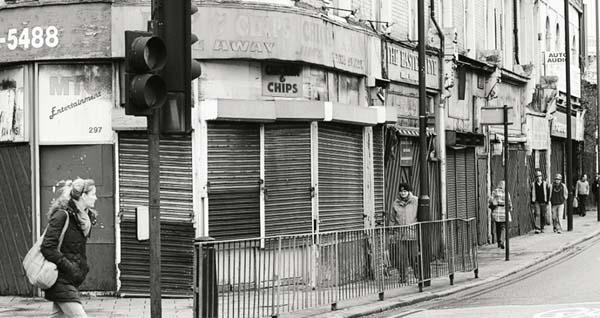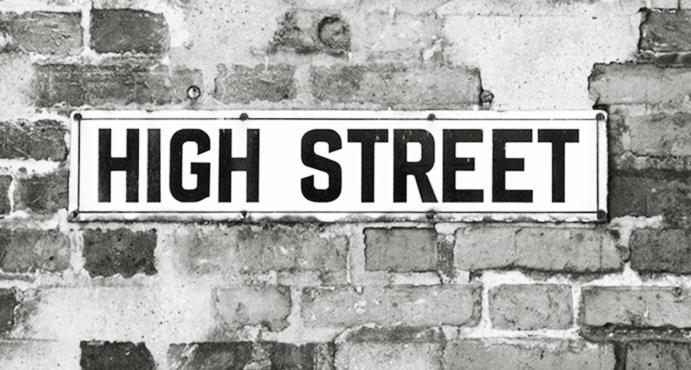英国街名:短小、简单、不做作
2018-01-05ByDavidButterfield
By David Butterfield

You know where you are with a British street name. I dont mean literally. I mean theres a tacit humility to our islands street names: They are short, simple and unpretentious.2
Our street names are soundest away from the city.3 The High Street is thriving: Its the commonest name in England and Wales, while Main Street leads the field in Scotland.4 Great Britain has some 3600 of the two. A “street” used to refer to a properly paved road, a practice imported by the Romans for their great connecting roads.5 Medieval journeymen stared in wonder at such “stone streets,” which flaunted a longforgotten technology.6
By the time of Henry I, streets were a protected brand: They should be wide enough for two carriages, or 16 knights on horseback.7 Roads were late coming: Shakespeare was the first to use the word. Its a happy fact that the City of London is so ancient as to have no “Roads.” These age-old differences are fossilised8 in our language: there are 600 “The Streets,” but there is no “The Road.”
Given the antiquity of the parish church, its understandable that there are more Church Lanes than Church Streets or Roads, which number 5500 together.9 But second most common are the 2000 Station Roads, almost all of which appeared in the latter half of the 19th century. Add Mill and School to these dominant names, and you have some 14,000 streets—but still not even 2 per cent of the nations named roads.

Street-naming was for centuries the result of informal village vernacular; in urban communities, pragmatism pointed out civic features, business quarters and fartherflung directions.10 Take York, for instance. That rickety medieval street, The Shambles, actually reflects the“fleshammels,” the meat shelves; the quaint Blossom Street is a banalisation of Ploughswain Street.11 As for the bizarre12 Whipmawhopmagate, one of the nations shortest streets, it seems to mean “Neither-one-thing-nor-the-other-street.”Nineteenth-century urbanisation increasingly commemorated aristocratic landowners, parliamentarians worth their salt, and battles in which locals fell.13 Still, few individuals are widely recognised across the countrys streets: Victoria is much in the lead, followed by Albert, Alexandra and Edward. More pointedly timeless are the myriad King and Queen Streets.14
New roads in the 20th century preferred to honour developers. But in the 21st century we are beset with councils and their wideeyed mission statements: Leyland boasts a Sustainability Way, Norwich a Friendship Road, Warrington a Sunset Boulevard.15 For no-nonsense Scots, Loanheads Costkea Way frames for all time the shopping prospects of Costco and Ikea.16 Modern developments are mere guesswork.17 The Cherries and The Normans (Slough) sound like forgotten barbershop ensembles of the late 1960s; Mango Place and Coconut Grove (Salford) are just unsuitable.18
The history preserved by street names is substantial19 and worthy of pride; it is sufficient to say that the commonest street name in America is “2nd.” But some questions remain unanswered: Why are there so many more West Streets than East?
1. unpretentious: 不矫揉造作的,谦逊的。
2. 我想说的是,我们国家的街道名都有一种低调的谦逊,具备三个特点:短小、简单、不做作。tacit:默认的,不言而喻的;humility: 谦逊。
3. 我們的街道名和城市几乎毫无关系。 sound: 充分的,彻底的。
4. 叫“高街”的街道有很多:它在英格兰和威尔士最为常见,而在苏格兰,街道用得最多的名字是“主街”。
5.“街道”通常是指精心铺设的道路,罗马人最早使用了这种方式来建造他们的主干道。
6. in wonder: 惊讶地,惊奇地;flaunt: 夸示,炫耀。
7. carriage: 马车;knight: 骑士。
8. fossilise: 使……成化石,此处指永久留存。
9. 考虑到牧区教堂悠久的历史,我们便能很快理解为什么“教堂小巷”的数量要远远多于“教堂街”和“教堂路”了,总共有5500个。antiquity: 久远的年代,古物;parish church: 牧区教堂。
10. 几个世纪以来,给街道命名都深受非正式的乡村方言的影响;实用主义理论则揭示了城市街道命名的三大特点:市民性、商业区的出现和广泛的方向性。vernacular: 本地话,方言;pragmatism:实用主义;farther-flung: 广泛的。
11. 破破烂烂的中世纪街道——谢姆伯街,事实上指的是“肉铺街”;而古老的“花街”实则是“把犁人街”的一种庸俗化说法。rickety: 摇摇晃晃的,快散架的;fleshammel: 中世纪的肉类市场; banalisation: 庸俗化;ploughswain:把犁人。
12. bizarre: 古怪的。
13. 19世纪,随着城市化的发展,道路名逐渐开始用于纪念贵族地主、值得尊敬的国会议员以及本国失败的战役。urbanisation: 城市化;commemorate: 纪念;aristocratic: 贵族的;parliamentarian:国会议员;worth sbs salt: 名副其实的,值得尊敬的。
14. pointedly: 明显地,强调地;timeless: 经久不衰,不受时间影响的;myriad: 极大数量的。
15. 然而,到了21世纪,道路名称则充斥着委员会和他们雄心勃勃的宣告:莱兰建设了一条“可持续大道”,诺里奇建设了一条“友谊大道”,而沃灵顿则建了一条“日落大道”。be beset with: 充满;Leyland: 莱兰,英国地名;Norwich: 诺里奇,英格兰最古老的城镇之一;Warrington:沃灵顿,英国地名;boulevard: 大道,林荫大道。
16. 对于一本正经的苏格兰人来说,伦黑德的科斯特基亚街一直以来都是仓储量贩店“好市多”和家具城“宜家”的经营前景和方向。nononsense: 正经的;Loanhead: 伦黑德,英国地名;prospect: 前景;Costco: 好市多,美国最大的连锁会员制仓储量贩店;Ikea: 宜家,瑞典的全球知名的家具和家居零售商。
17. mere: 仅仅的;guesswork: 猜想,猜测。
18. 斯劳的“樱桃路”和“诺曼人路”听起来像20世纪60年代晚期已被遗忘的理发店名字的集合;而索尔福德的“芒果地路”和“椰子林路”则显然完全不适合当街道名使用。Slough: 斯劳,英国地名;barbershop: 理发店;ensemble: 集合,整体;coconut grove:椰子林;Salford: 索尔福德,英国地名。
19. substantial: 可观的,数目巨大的。
